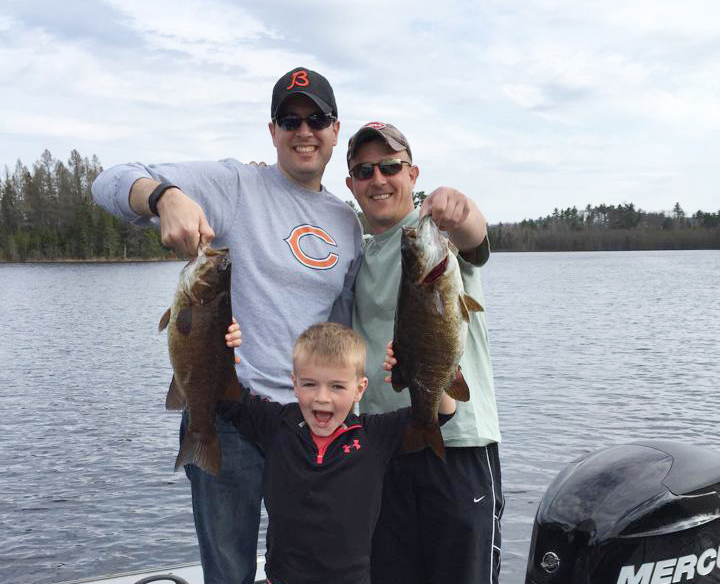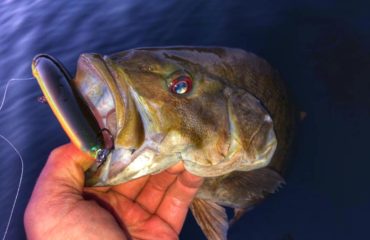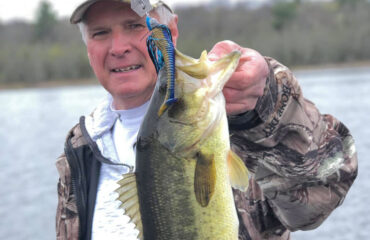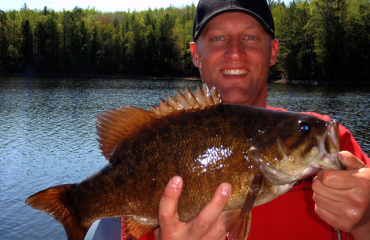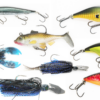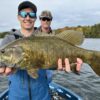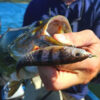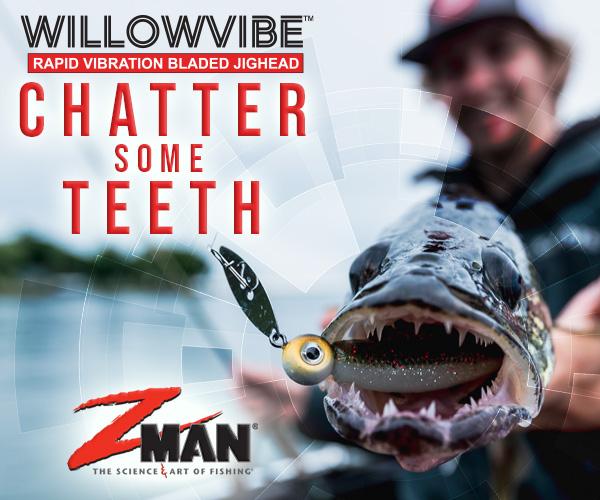Weekend Warrior Fishing
By Andrew Ragas
Friday nights through Sunday nights are what some fishing die-hards have to live for. Every weekend is a quick fishing vacation that occurs four times a month. Pack the vehicle and boat Thursday night, and show up to work Friday. Productivity level is low, but anticipation level and excitement is high. When the clock strikes five they are in transit, fighting past rush hour traffic to their favorite drive-to fishing destinations where they will be at until returning home Sunday night, or to the office again early Monday morning. Meet the weekend warrior. What a life.
Corporate America, school, work responsibilities, not enough vacation time, bills and mortgages, marriage, little kids running around the house plus family life. These are just a few of the major reasons why many serious anglers are unable to fish as often as they desire. But some fishermen are wise and resourceful, taking advantage of whatever opportunities they can get. So they settle for weekend trips every month, each weekend, four times per month.
To the weekend warrior fisherman, as much variation and quantity of awesomeness is packed into every weekend as physically possible, warranting the rest of the work week to recharge in anticipation for the next weekend.
When the Friday workday ends, many weekend warriors travel northward.
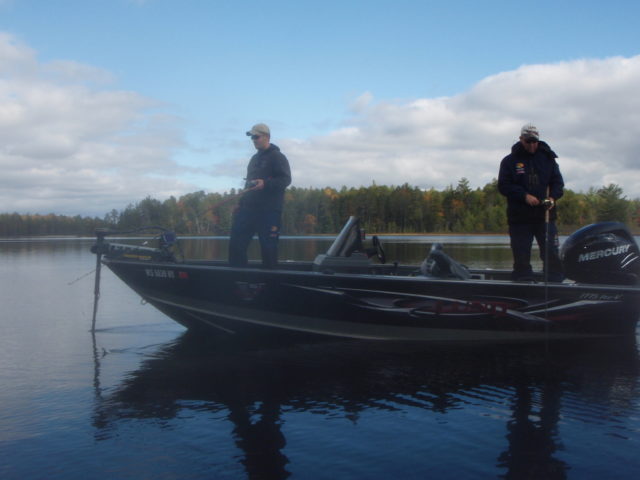
A Convenient and Realistic Weekend Fishing Destination
Wisconsin’s Northwoods is a popular fishing destination for vacationers, tourists, expert anglers and tournament pros. This region is located a 3 hours drive from Wisconsin’s urban hubs of Milwaukee, Madison and Green Bay, 4 hours from Minneapolis, and 5 hours from Chicago. Most weekend warriors work and reside at these urban centers, so it’s a realistic and convenient commute for them to make for an action packed 2 days of fishing.
Vilas County is the perfect centrally located fishing destination for most weekend warriors I know. The region has been frequented and visited by weekend warrior anglers for several generations. Its diversity of lakes and fisheries, and public accessibility makes it one of the most unique drive-to Midwest fishing destinations. A multi-species fishing opportunity at the hundreds of publicly accessible lakes, and the convenience of traveling to them, is the weekend warrior allure and draw.
Illinoisans, Southern Wisconsinites, Yoopers, and Eastern Minnesotans are greatly limited to only a handful of productive inland bodies of water, or the Great Lakes, and very little to none local fishing-related tourist attractions. Most northwoods communities successfully draw tourists through seasonal fishing and hunting, and are privileged enough to still have [mostly] healthy and maintained fisheries that are home to tremendous populations of muskie, northern pike, walleye, both species of bass, and panfish. The hundreds of lakes and short distances between boat landings allows for ease of travel and lake hopping. This factor is very precious for time management and maximizing fishing productivity for a weekend warrior.
Weekend Warrior Itinerary
Pack the car and boat Thursday night, because after Friday’s uneventful day at work you’ll be commuting northbound with partners on a combination of US Highways 51, 41, 10, 8, and 43. Working too much in life is bad, but worth the battle when you arrive at your weekend fishing destination.
Weekend warriors eat, sleep, and fish from their boats the next 48 hours before returning to their jobs, only to repeat again the following week.
Marathon weekend trips are short and condensed, but often packed with fishing excitement from sunrise to sunset. Some weekend warriors fish thru all-niters depending on how good the bite is, while others will rest and sleep only when necessary. Some weekend warriors fish the entire weekend without stopping, while others visit a few of the many Northwoods bars and taverns for food and drink, and entertainment breaks in between.

Delicious food, drink, and hospitality is served at Fibbers Bar and Restaurant – St. Germain, Wisconsin
An unfortunate reality of being an adult and productive member of society is weekend warriors work more and fish less. Time is precious and because of limited fishing time, it’s most difficult for a weekend warrior to pattern the best bites at their fishing destination. Not every angler is fortunate to be able to invest time on the water. But expert weekend warriors have the know-how and wherewithal to make this lifestyle and fishing strategy successful for them every weekend.
Four Trips Per Month, Every Month of the Year
There are over 2,300 different lakes to choose from in the region I fish in the Minocqua region of Wisconsin. This overabundance of lakes within a 50 mile radius is overwhelming for weekend warriors without hiring a guide. Joining my groups of friends over the years on their weekend fishing marathons, and partaking on my own during my college years, has led me to helping today’s weekend warriors with a resourceful and innovative fishing guide to help planning weekend fishing trips to Wisconsin’s northwoods.
Northern Wisconsin’s true calendar fishing season opens at midnight on the first Saturday of May. Weekend warriors travel northward on Friday night after work. When the clock strikes midnight, gamefish season opens.
May – Following ice-out, May fishing is characterized by shallow water fishing, as all gamefish and panfish species are infiltrating the shallows for their spawning seasons and feeding. Fishing will be excellent until Memorial Day weekend, the official start of the tourist season.
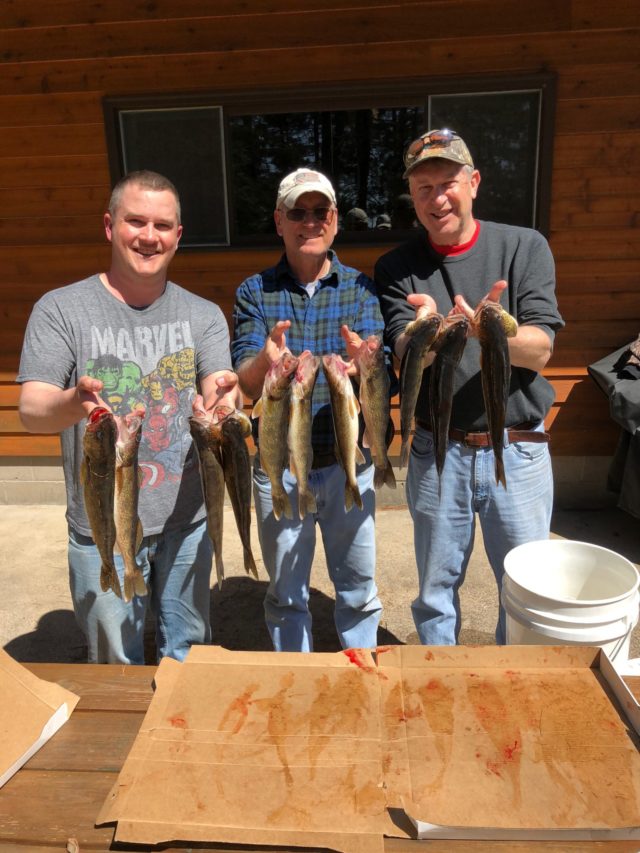
The opening weekend crew of Steve and Bob Peterson, with Ray Pecora, make walleye fish fries a yearly season opening tradition in St. Germain, Wisconsin. Limits of eater walleyes from the lakes and flowages are common.
Many weekend warriors drive straight to the lake and begin the year overnight walleye fishing at midnight. Most weekend warriors prioritize walleye fishing, as their spawn can either be ongoing or completing. Their bite is the strongest and most aggressive all month on lakes, rivers, and flowages. They’re caught casting crankbaits to rock and gravel shorelines after dark to spawning fish, and rip jig staging locations during midday hours. Harvesting the huge stringers of years past is no longer promoted in the Northwoods. Nowadays, selective harvest is suggested and enforced, as some lakes have special regulations and all have 20-24” protected slot limits to help maintain natural reproduction and increase size structures. For the remainder of May, walleye are abundant in shallower habitat as they will eventually transition to wood and weeds for early summer.
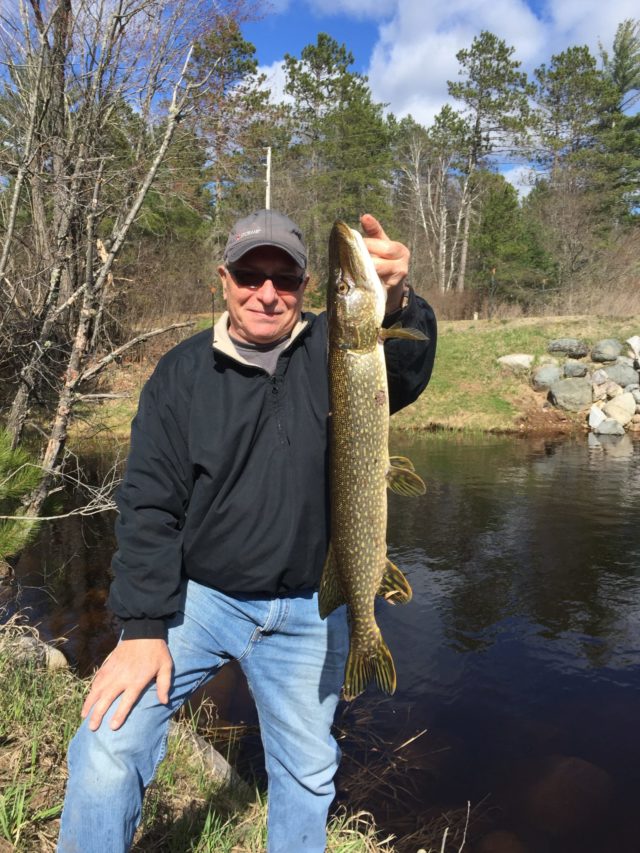
Northern pike are aggressive and active in May’s cool waters. Their heavy post-spawn feeding in shallow bays makes fishing efforts worthwhile. Mike Piorkowski with a catch and release 30 incher.
Northern pike are common, and targeting them in fast-warming mud and weed bays can be enjoyable and exciting in spring.
Crappies are popular too, and their fishing is spectacular on calm, warm days. They’re a good fallback option to weekend warriors when other species aren’t cooperative. Many lakes are abundant with crappies and fishing is action-packed in the weedy and wooded shallows of spawning bays. All you need to be equipped with is a light action spinning rod, a handful of floats and 1/32 oz. jigs, and Kalin’s Crappie Scrubs. The bite is good through early June.
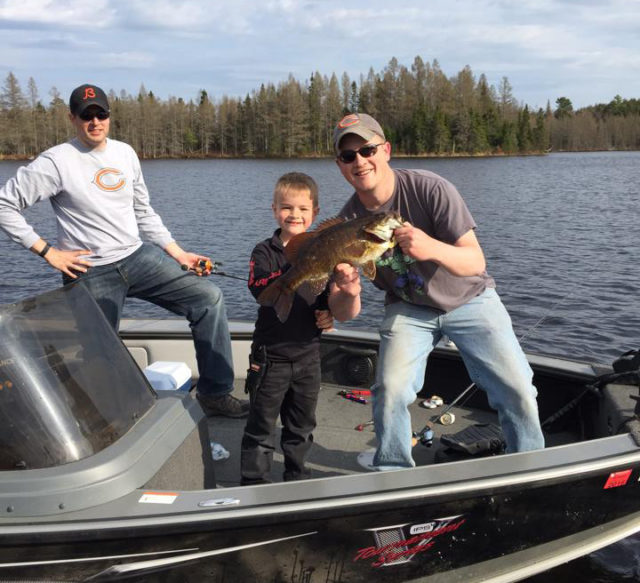
Many out of state visitors travel on weekends to take advantage of Vilas County’s world class smallmouth bass where the pre-spawn bite peaks during the second and third weeks of the month. Numbers days with upwards of 50 to 100 fish caught and released can be possible.
Big smallmouth and largemouth bass have gained popularity and notoriety in the north. Many out of state visitors travel on weekends to take advantage of Vilas County’s world class smallmouth bass where the pre-spawn bite peaks during the second and third weeks of the month. Numbers days with upwards of 50 to 100 fish caught and released can be possible.
Muskie season opens the Saturday of Memorial Day Weekend. Recuperated male fish are most common catches from the dams of river systems, creeks and bays of flowages, and warm shallow bays of lakes.
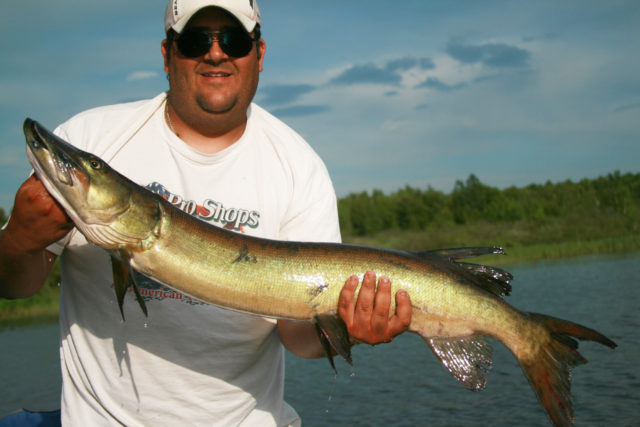
Memorial day weekend is the official start to the muskie season. Shallow water fishing is successful for active, feeding fish that have recovered from the rigors of spawn.
Some years it’s nice out while other years it’s cold and crummy. Plan all May fishing efforts around the weather and timing of the spawn. Night fishing for walleyes is a huge incentive that prolongs weekend fishing, and caters best to weekend warriors.
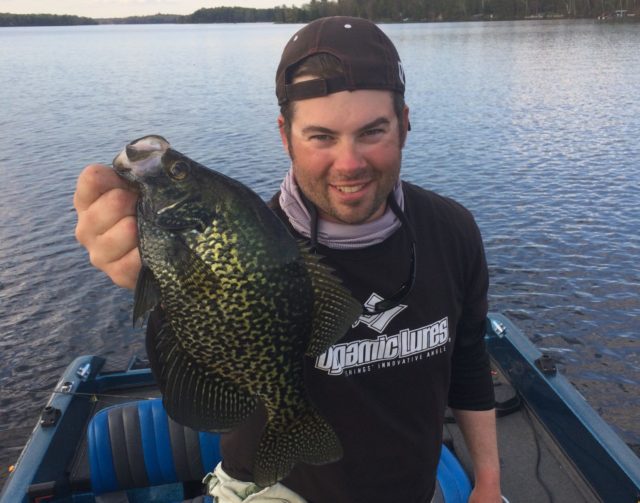
Crappies are popular in spring, and their fishing is spectacular on calm, warm days. They’re a good fallback option to weekend warriors when other species aren’t cooperative. Many lakes are abundant with crappies and fishing is action-packed in the weedy and wooded shallows of spawning bays. All you need to be equipped with is a light action spinning rod, a handful of floats and 1/32 oz. jigs, and Kalin’s Crappie Scrubs. The bite is good through early June.
June – The spring spawn is tailing off for most species except largemouth bass, smallmouth bass, and bluegills. These centrarchid species are nesting for the first half of the month, making their shallow water fishing fun and a guaranteed bite. Bluegills are big, bullish, and explosive. Bass catches are the most numerous and abundant they’ll be this entire season.
Most other fish species are feeding heavy, and relating to the shallows and mid-depth areas with newly-formed habitat such as weeds.
Muskie fishing gains momentum and more anglers begin targeting them each weekend. A good moon phase and ideal weather combined with the success of night fishing and trolling efforts (< 10ft from surface), improves odds making the species a convenient but challenging one to pursue on a limited basis. The longest daylight hours of the season allows muskie fishermen, and all weekend warriors for the matter, to fish multiple lakes each day.
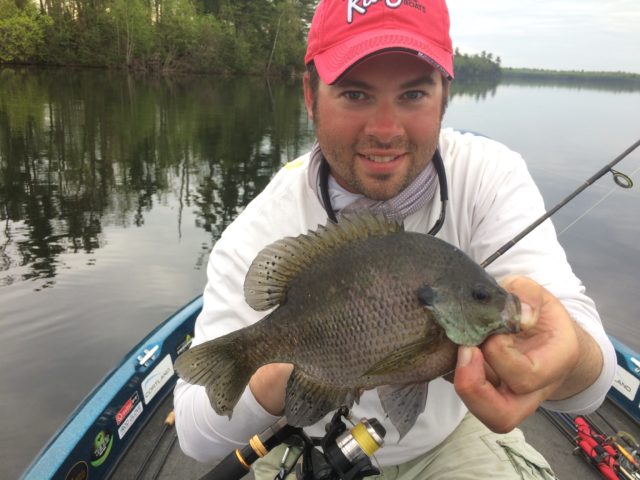
The bluegill bite peaks in early June on most lakes. Big bulls located around their spawning grounds provide action packed fishing. To maintain their fisheries, always release the bulls like this specimen.
July & August – By mid July, summer peak sets in. Water temperature and air temperature is the hottest of the year, making fishing efforts for all species a challenge. These months are the most popular for fishing, lake life, and all recreational boat traffic. Expert weekend warriors prioritize all fishing for early mornings, evenings, and overnight hours to capitalize on when most fish species are feeding and not being driven deep as a result of heat and boat traffic.
It’s advised to stay away from popular heavy traffic & pressured lakes and seek quieter water located off the beaten path, and away from main highways, where fishing pressure is lightest, and quality fishing can be best.
Panfish are deep and schooling offshore. Walleyes are living deep and offshore too, making use out of deep sand grass and rock piles.
Midsummer muskies are most active in low light conditions, early and late in the day. Prioritize fishing around the best moon phases, new moon and full moon. Additionally solunar calendar majors and minors help predicting feeding and activity levels too, as these could be the only time of day you’ll ever contact fish.
Unfortunately this time of season can be deadly to muskies, especially if surface temps are warmer than 78 degrees. Weekend warriors need to be educated that muskies will suffocate and die from exhaustion and lactic acid buildup when caught from hot, poorly-oxygenated water temps. Therefore a good fallback option for summer midday fishing is largemouth bass. This warm water species responds best from all lakes on hot days, heat waves, and midday’s warmest water temps.
Want smallmouth too? Their daytime locations may consist of deep rock and main-lake offshore structure, and open water where some suspend and chase ciscoes. Early mornings and evenings they will return to the shallows and feed on baitfish and crayfish.
Beat the heat and night fish in summer. Focus on deep, cold, clear lakes that stay coolest and don’t effectively absorb the suns heat. Avoid fishing muskies anytime water temperatures are warmer than 78 degrees. Any weather change and fishing during a major and minor are also a positive.
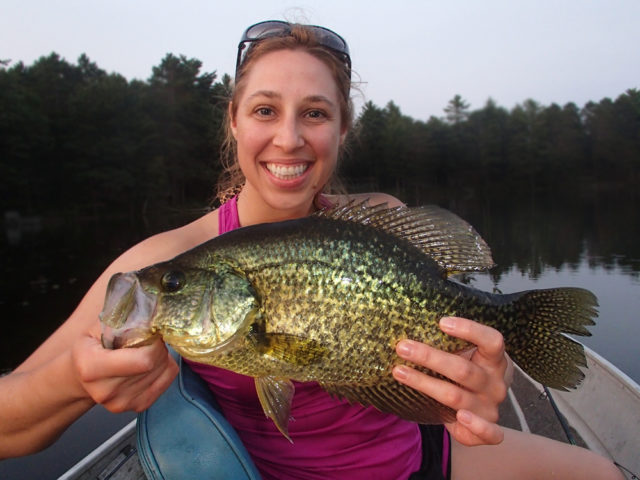
Crappies are year-round favorites for weekend anglers looking for action and quick fun. The author’s fiancée, Amanda, enjoys fishing the northwoods for crappies most, where catching and releasing giants like this 16 and a half incher is a real possibility on some lakes.
September – After Labor Day weekend, the region clears and most lakes empty. Tourists and vacationers leave, and hunters seek the woods. Majority of all boats and cottages end up getting winterized, and a little too prematurely. Fish are mostly unpressured and some not fished at all. This is the best and most pleasant time of the season to be out on the water because a weekend warrior doesn’t have to worry about fishing pressure and competition from other weekend traffic.
September is a month of transition for all species. In response to cooling water temperatures muskies return to the weedy shallows where they will be feeding until turnover. It’s the best time of season for action on topwater and bucktails.
Northern pike are most active and aggressive on dark, overcast, miserable weather days. Largemouth bass seek out the deepest and greenest of remaining weedgrowth. Smallmouth bass begin their fall overwintering migrations where they will settle in wintering holes for all of winter until the following spring ice-out. Walleye and panfish school heavily too, seeking the basins of deep holes. Whack n stack, baby.
With every passing coldfront, the bite accelerates for all species. September is transition to winter. Every available fishing day becomes more precious.
October & November – Cold water fishing sets in. October anglers have to pattern their fishing and locations according to the phases of turnover. In November, ice formation and wintering locations then dictates where to fish.
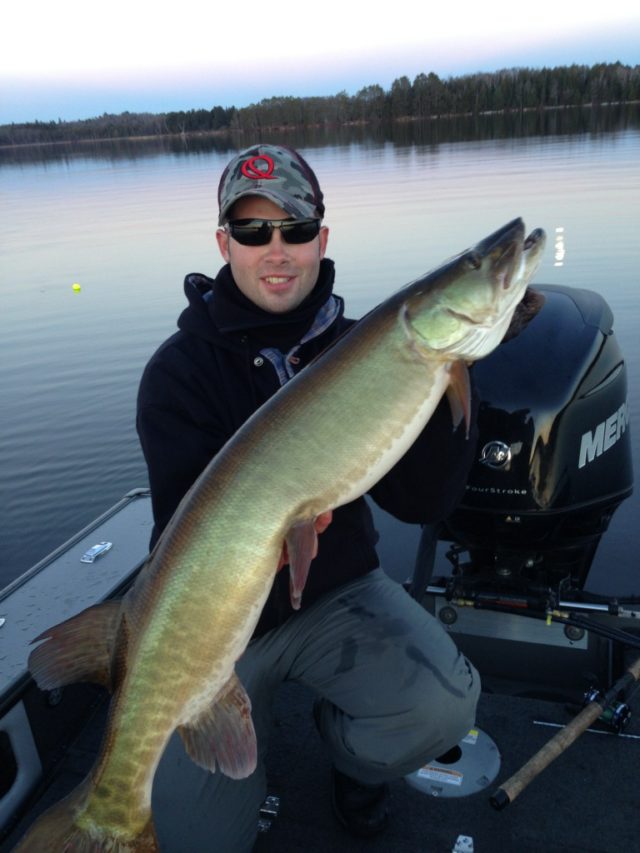
In November the only anglers fishing are muskie die-hards, seeking a late season giant. Muskie patterns late in autumn mainly dwell on timing of the cisco spawn under full moon, and lunar periods. A combination of livebait and trolling is most successful as fall progresses.
The biggest attraction on most lakes this time of season is musky fishing. Livebait fishing, casting, and trolling during brutal cold are the most popular fall fishing methods. Livebait fishing is an art, and a Northwoods tradition. The most successful anglers and guides are utilizing intricate quick-strike rigging systems to present 12 to 18 inch wild suckers by long lining them (swimming), suspending at boatside, or running behind a float. The liveliest sucker minnows catch the most muskies. The fall sucker bite peaks during the second and third weekends of October, and remains effective until first ice. Multiple bites per day can be had.
In November the only anglers fishing are muskie die-hards, seeking a late season giant. Muskie patterns mainly dwell on timing of the cisco spawn under full moon, and lunar periods. A combination of livebait and trolling is most successful as fall progresses.
December through February – Wisconsin’s ice fishing season lasts 3 months. Northwoods ice fishermen seem to be divided into two demographics: Hard core ice addicts who are more serious about hard water than open water; and social anglers, who ice fish for no particular reason other than to have a good time. Weekend warriors fit into both categories, and ice fishing trips are much easier to execute than open water season trips.
Ice build is usually firm enough on most lakes by December 1st. Walleye, pike, perch and bluegill dominate the first ice scene, where the species migrate back to shallow green weeds and structure to feed. Jigging techniques score walleyes and panfish, while strategic placement of tip-ups with shiners and suckers catches walleye and pike.
Sunny, high pressure days get fish active. So does the presence of remaining green weeds. Deep sand grass is a magnet for walleyes, and odds of catching them are exponential after dark.
By mid-winter in January and February most fish species migrate back to the deep basins of lakes. Crappies stack in deep holes, while perch and walleyes seek mud basins and transition areas.
Late ice northern pike are shallow and active again on warm days, caught on quick strike rigged tip-ups with large live bait and dead bait.
March and April – The gamefish season closes after the first weekend of March. This closure allows pressured and overfished walleyes, and all gamefish species, to seek refuge and recuperation for the spring spawn following ice-out.
By now ice conditions are deteriorating. Late-ice panfish and some open river systems are the only viable fishing options. Most Northwoods communities will be ghost towns until season opener.
Most weekend warriors are now preparing their boats and equipment for the upcoming open water season to repeat the process all over again. Or visit the Great Lakes tributaries and other nearby states to take advantage of their open fishing seasons.
Friday through Sunday Night. Repeat Every Weekend.
Work more and fish less? Take the lemons life gives you and make the best of it. Settling for weekend trips every month, each weekend, four times per month is the solution. 96 days of available fishing can be had.
Many drive-to fishing destinations within reasonable travel distance and attractive fishing are prevalent throughout the Midwest, but few cater as well to anglers in Midwest cities like Wisconsin’s Vilas County does.
Is being a weekend warrior the right fishing lifestyle for you? Utilize this guide to help prolong your fishing career on a weekends-only basis.
Andrew Ragas splits time between the Chicago area and Wisconsin’s Northwoods. Based in Minocqua, WI, he specializes in trophy bass fishing and offers guided trips from May thru October. While big bass is the passion, he dabbles in multi-species as well. He may be visited online at www.northwoodsbass.com


